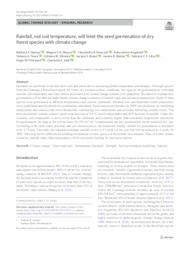Rainfall, not soil temperature, will limit the seed germination of dry forest species with climate change.
Rainfall, not soil temperature, will limit the seed germination of dry forest species with climate change.
Author(s): DANTAS, B. F.; MOURA, M. S. B. de; PELACANI, C. R.; ANGELOTTI, F.; TAURA, T. A.; OLIVEIRA, G. M.; BISPO, J. S.; MATIAS, J. R.; SILVA, F. F. S.; PRITCHARD, H. W.; SEAL, C. E.
Summary: Drylands are predicted to become more arid and saline due to increasing global temperature and drought. Although species from the Caatinga, a Brazilian tropical dry forest, are tolerant to these conditions, the capacity for germination to withstand extreme soil temperature and water deficit associated with climate change remains to be quantified. We aimed to evaluate how germination will be affected under future climate change scenarios of limited water and increased temperature. Seeds of three species were germinated at different temperatures and osmotic potentials. Thermal time and hydrotime model parameters were established and thresholds for germination calculated. Germination performance in 2055 was predicted, by combining temperature and osmotic/salt stress thresholds, considering soil temperature and moisture following rainfall events. The most pessimistic climate scenario predicts an increase of 3.9 °C in soil temperature and 30% decrease in rainfall. Under this scenario, soil temperature is never lower than the minimum and seldomly higher than maximum temperature thresholds for germination. As long as the soil moisture (0.139 cm3 cm3) requirements are met, germination can be achieved in 1 day. According to the base water potential and soil characteristics, the minimum weekly rainfall for germination is estimated to be 17.5 mm. Currently, the required minimum rainfall occurs in 14 weeks of the year but will be reduced to 4 weeks by 2055. This may not be sufficient for seedling recruitment of some species in the natural environment. Thus, in future climate scenarios, rainfall rather than temperature will be extremely limiting for seed germination.
Publication year: 2020
Types of publication: Journal article
Unit: Embrapa Semi-arid Region
Observation
Some of Embrapa's publications are published as ePub files. To read them, use or download one of the following free software options to your computer or mobile device. Android: Google Play Books; IOS: iBooks; Windows and Linux: Calibre.
Access other publications
Access the Agricultural Research Database (BDPA) to consult Embrapa's full library collection and records.
Visit Embrapa Bookstore to purchase books and other publications sold by Embrapa.

